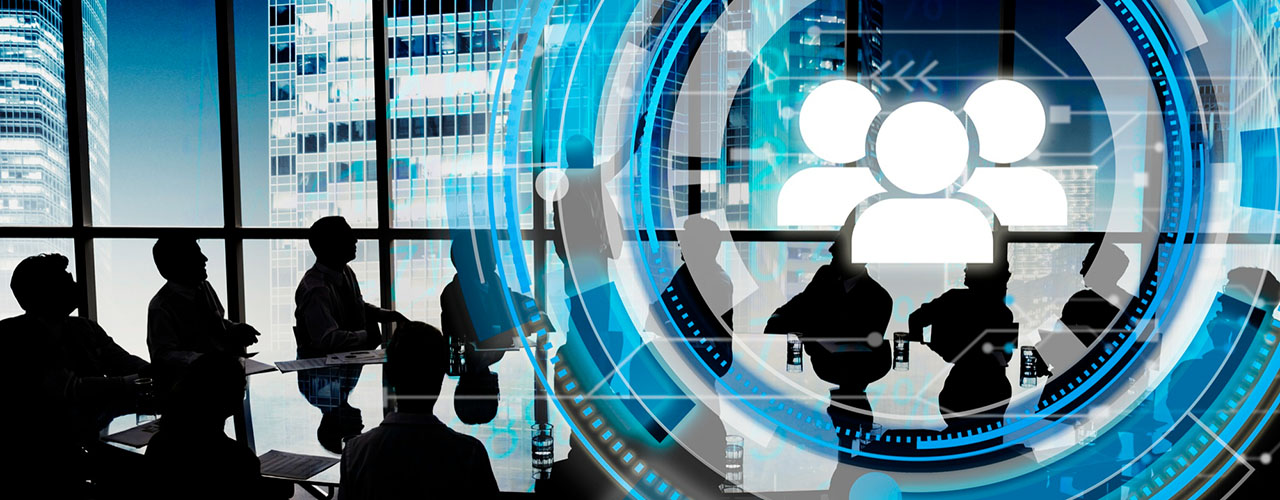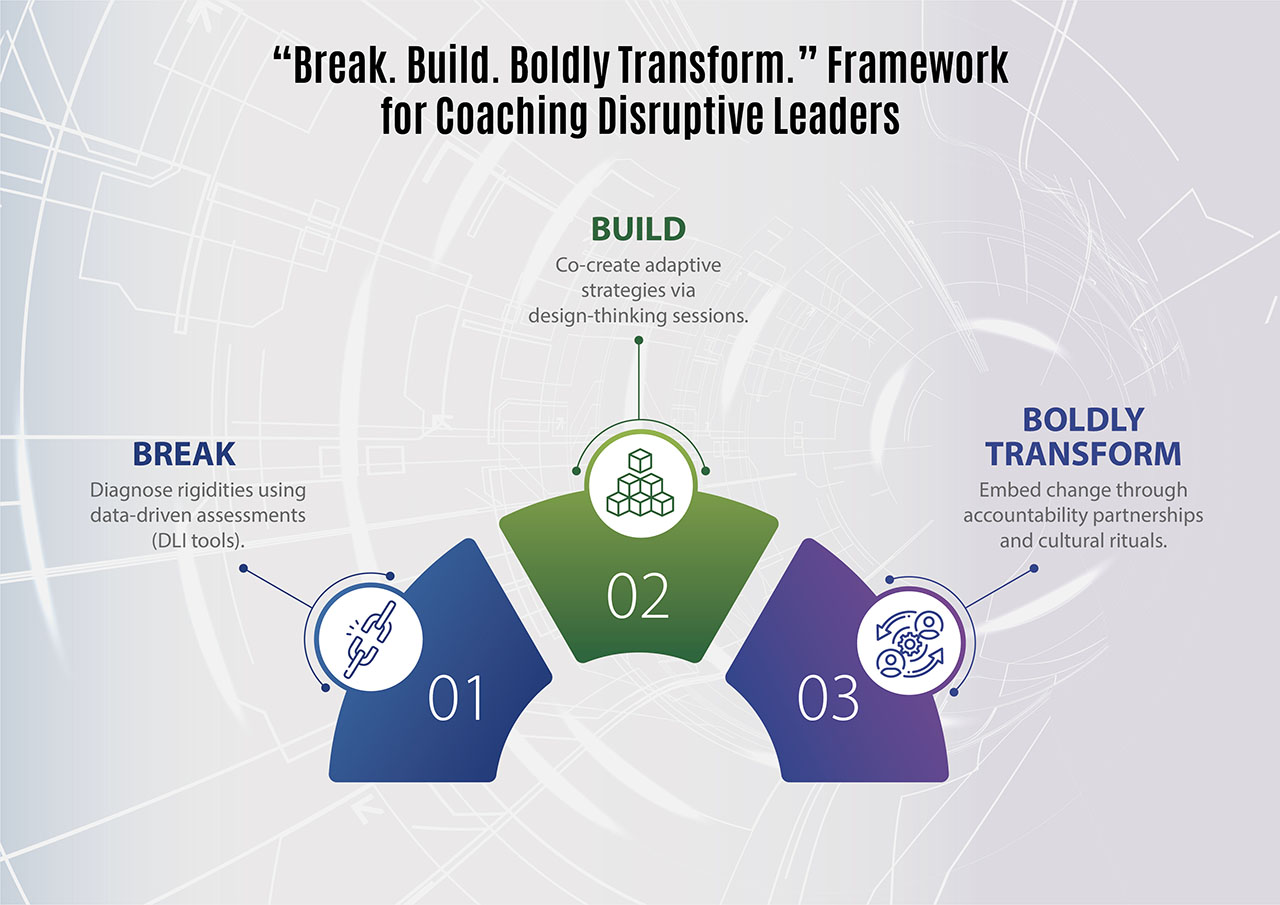Disruption is not chaos — it is creation in motion.
Coaching Disruptive Leaders: Break. Build. Boldly Transform.
Introduction: Coaching for the Age of Disruption
We live in an era defined by accelerating change, uncertainty, and complexity.
Technological shifts, global crises, and evolving workforce expectations are transforming how organizations operate — and how leaders must lead. Traditional approaches to leadership development no longer suffice.
At the Disruptive Leadership Institute (DLI), our mission is to prepare future-ready leaders who can thrive amid volatility, not just survive it.
Through our Best Practice Coaching Framework — “Break. Build. Boldly Transform.” (see Figure 1) — we equip CEOs, C-Suite Executives, and Board Members with the cognitive readiness, agility, and resilience needed to lead in times of turbulence.
Figure 1: “Break. Build. Boldly Transform.” Framework for Coaching Disruptive Leaders
Grounded in research from DLI’s acclaimed Future-Ready Leadership book series, this framework has been tested globally across industries and cultures. It provides a clear roadmap for developing the Disruption Mindset — the capacity to challenge assumptions, reimagine possibilities, and drive transformation with courage and purpose.
On the 3rd October 2025, at the 2025 Executive & Business Coaching Forum in Moscow, Russia, DLI’s CEO & C-Suite Master Executive Coach shared a message that resonated deeply with the audience globally:
In this era of relentless change, leaders must learn to “Break. Build. and Boldly Transform.” — the three pillars of DLI’s Best Practice Coaching Framework for developing future-ready disruptive leaders.
The Three Pillars of the DLI Coaching Framework
The Break. Build. Boldly Transform. framework reflects the natural cycle of leadership growth and organizational renewal.
Each pillar represents a mindset shift, a behavioral transformation, and a set of best practices that coaches use to guide leaders through disruption.
1. BREAK — Challenging the Status Quo
Core Idea:
Before leaders can reinvent their organizations, they must first unlearn and let go.
The Break phase is about identifying and dismantling outdated mental models, structures, and leadership habits that inhibit growth.
Purpose of “Break”
Coaching Objectives
- Uncover blind spots that limit innovation.
- Disrupt comfort zones by confronting legacy systems and thinking patterns.
- Develop cognitive agility to reframe challenges from threat to opportunity.
Best Practice Coaching Techniques
- Provocative Questioning:
Coaches ask high-impact questions that surface limiting beliefs.
“What are you protecting that no longer creates value?”
“Which success stories from the past are now barriers to future success?” - Unlearning Exercises:
Guided reflection helps leaders identify behaviors or decisions driven by outdated paradigms. - Reframing Conversations:
Coaches help leaders reinterpret disruption as a signal for reinvention, not failure.
Outcome
They learn that breaking is not destruction — it’s liberation. It clears the space for innovation and courageous rebuilding.
2. BUILD — Reimagining and Reconstructing
Core Idea:
Once the old has been dismantled, leaders must imagine and create what’s next.
The Build phase centers on designing bold, adaptive, and purpose-driven strategies that position organizations for long-term relevance.

Purpose of “Build”
Coaching Objectives
- Activate creative and systems thinking to envision new possibilities.
- Encourage experimentation through rapid learning and iteration.
- Develop human-centered leadership, aligning innovation with empathy and purpose.
Best Practice Coaching Techniques
- Future-Back Thinking:
Coaches guide leaders to envision their ideal future state and reverse-engineer the steps required to achieve it.
“If your organization were founded today, what would it look like?” - Moonshot Mapping:
Leaders are coached to think 10x, not 10%. They identify bold initiatives that deliver exponential value. - Collaborative Co-Creation:
Coaches help leaders engage teams in designing solutions, fostering ownership and trust.
Outcome
They begin to build organizations that are agile by design — driven by innovation, collaboration, and purpose.
3. BOLDLY TRANSFORM — Leading with Courage and Cognitive Readiness
Core Idea:
Transformation demands courage.
The Boldly Transform phase is about embodying the mindset and emotional intelligence required to lead through uncertainty, inspire others, and sustain long-term change.

Purpose of “Boldly Transform”
This pillar helps leaders develop the inner capacity to lead with resilience, empathy, and integrity even when outcomes are unpredictable.
Coaching Objectives
- Strengthen cognitive readiness — the ability to make sound decisions under ambiguity.
- Cultivate emotional resilience and mindfulness to navigate stress.
- Empower authentic leadership that aligns personal values with organizational purpose.
Best Practice Coaching Techniques
- Fear-to-Fuel Reframing:
Coaches help leaders reframe fear and anxiety as energy for action and innovation. - Resilience Coaching:
Techniques drawn from positive psychology and neuroscience build leaders’ adaptability and optimism. - Values Clarification:
Leaders articulate their guiding principles to sustain ethical and purpose-driven transformation.
Outcome
They recognize that transformation is not a one-time initiative, but a continuous cycle of renewal.
The Role of the Coach: Catalyst for Disruptive Growth
Within the Break. Build. Boldly Transform. framework, the coach plays a pivotal role — not as an instructor, but as a strategic thinking partner and catalyst.

DLI’s Master Executive Coaches guide leaders through structured reflection, targeted feedback, and future-oriented dialogue. They use metrics and milestones to measure both behavioral change (leading indicators) and business impact (lagging indicators), ensuring sustainable growth.
Through this process, coaching becomes not a transactional intervention, but a transformational partnership — unlocking leadership potential, organizational agility, and systemic resilience.
Integrating the Framework Across the Organization
The Break. Build. Boldly Transform. framework extends beyond individual coaching to organizational transformation. DLI helps enterprises embed the model into their leadership pipelines, culture initiatives, and strategy execution processes.

Applications Include:
- CEO and C-Suite Coaching: Enhancing cognitive readiness and strategic agility.
- Team Coaching: Building cohesive, innovative, and high-trust leadership teams.
- Culture Transformation Programs: Embedding disruption resilience across the organization.
- Succession & Talent Development: Preparing the next generation of future-ready leaders.
Conclusion: Leading the Future with a Disruption Mindset
The future will belong to leaders who are willing to break what’s comfortable, build what’s possible, and boldly transform what’s essential.
The Disruptive Leadership Institute’s Best Practice Coaching Framework equips leaders and organizations with the mindset and methods to navigate — and lead — through turbulence.
In times of disruption, coaching is not a luxury; it’s a leadership imperative.
Because in a world that refuses to stand still, the most powerful strategy a leader can adopt is to keep evolving.
References:
- Sattar Bawany (2025), The Making of a C.R.I.S.I.S. Leader. Business Expert Press (BEP) LLC, New York, NY.
- Sattar Bawany (2023), Leadership in Disruptive Times: Negotiating the New Balance. Business Expert Press (BEP) LLC, New York, NY.
- Sattar Bawany (2020), Leadership in Disruptive Times. Business Expert Press (BEP) LLC, New York, NY.
- Sattar Bawany (2019), Transforming the Next Generation of Leaders. Business Expert Press (BEP) LLC, New York, NY.


